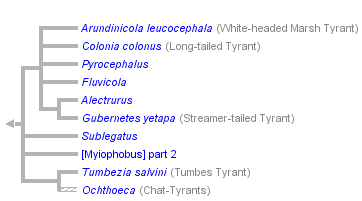Fluvicolini



This tree diagram shows the relationships between several groups of organisms.
The root of the current tree connects the organisms featured in this tree to their containing group and the rest of the Tree of Life. The basal branching point in the tree represents the ancestor of the other groups in the tree. This ancestor diversified over time into several descendent subgroups, which are represented as internal nodes and terminal taxa to the right.

You can click on the root to travel down the Tree of Life all the way to the root of all Life, and you can click on the names of descendent subgroups to travel up the Tree of Life all the way to individual species.
For more information on ToL tree formatting, please see Interpreting the Tree or Classification. To learn more about phylogenetic trees, please visit our Phylogenetic Biology pages.
close boxDiscussion of Phylogenetic Relationships
The traditional genus Myiophobus is polyphyletic (Tello et al. 2009, Ohlson et al. 2008), and this fragment will need a new name. The old name appears in brackets as a placeholder. The genus name goes with the type species, M. fasciatus, here.
Ochthoeca, in addition to being polyphyletic (several traditional species forming the genus Silvicultrix, outside Fluvicolini) may also be paraphyletic, including Tumbezia and even "[Myiophobus], part 2", though support is weak (Tello et al. 2009, Ohlson et al. 2008).
References
Ohlson, J., J. Fjeldså, and P. G. P. Ericson. 2008. Tyrant flycatchers coming out in the open: Phylogeny and ecological radiation of Tyrannidae (Aves, Passeriformes). Zoologica Scripta 37:315-335.
Tello, J. G., R. G. Moyle, D. J. Marchese, and J. Cracraft. 2009. Phylogeny and phylogenetic classification of the tyrant flycatchers, cotinga, manakins, and their allies (Aves: Tyrannides). Cladistics 25:1-39.
Title Illustrations

| Scientific Name | Pyrocephalus rubinus |
|---|---|
| Location | Tucson, Pima County, Arizona, USA |
| Comments | The Vermilion Flycatcher, Pyrocephalus rubinus, is a small passerine bird that can be found in the southwestern United States, Central America, and northern and central South America, and southwards to central Argentina. |
| Specimen Condition | Live Specimen |
| Source | Vermilion Flycatcher |
| Source Collection | Flickr |
| Image Use |
 This media file is licensed under the Creative Commons Attribution-NonCommercial-ShareAlike License - Version 2.0. This media file is licensed under the Creative Commons Attribution-NonCommercial-ShareAlike License - Version 2.0.
|
| Copyright | © 2009 Wayne Dumbleton |
About This Page
Page copyright © 2009
 Page: Tree of Life
Fluvicolini.
The TEXT of this page is licensed under the
Creative Commons Attribution-NonCommercial License - Version 3.0. Note that images and other media
featured on this page are each governed by their own license, and they may or may not be available
for reuse. Click on an image or a media link to access the media data window, which provides the
relevant licensing information. For the general terms and conditions of ToL material reuse and
redistribution, please see the Tree of Life Copyright
Policies.
Page: Tree of Life
Fluvicolini.
The TEXT of this page is licensed under the
Creative Commons Attribution-NonCommercial License - Version 3.0. Note that images and other media
featured on this page are each governed by their own license, and they may or may not be available
for reuse. Click on an image or a media link to access the media data window, which provides the
relevant licensing information. For the general terms and conditions of ToL material reuse and
redistribution, please see the Tree of Life Copyright
Policies.
- First online 28 November 2009
- Content changed 28 November 2009
Citing this page:
Tree of Life Web Project. 2009. Fluvicolini. Version 28 November 2009 (temporary). http://tolweb.org/Fluvicolini/138998/2009.11.28 in The Tree of Life Web Project, http://tolweb.org/







 Go to quick links
Go to quick search
Go to navigation for this section of the ToL site
Go to detailed links for the ToL site
Go to quick links
Go to quick search
Go to navigation for this section of the ToL site
Go to detailed links for the ToL site